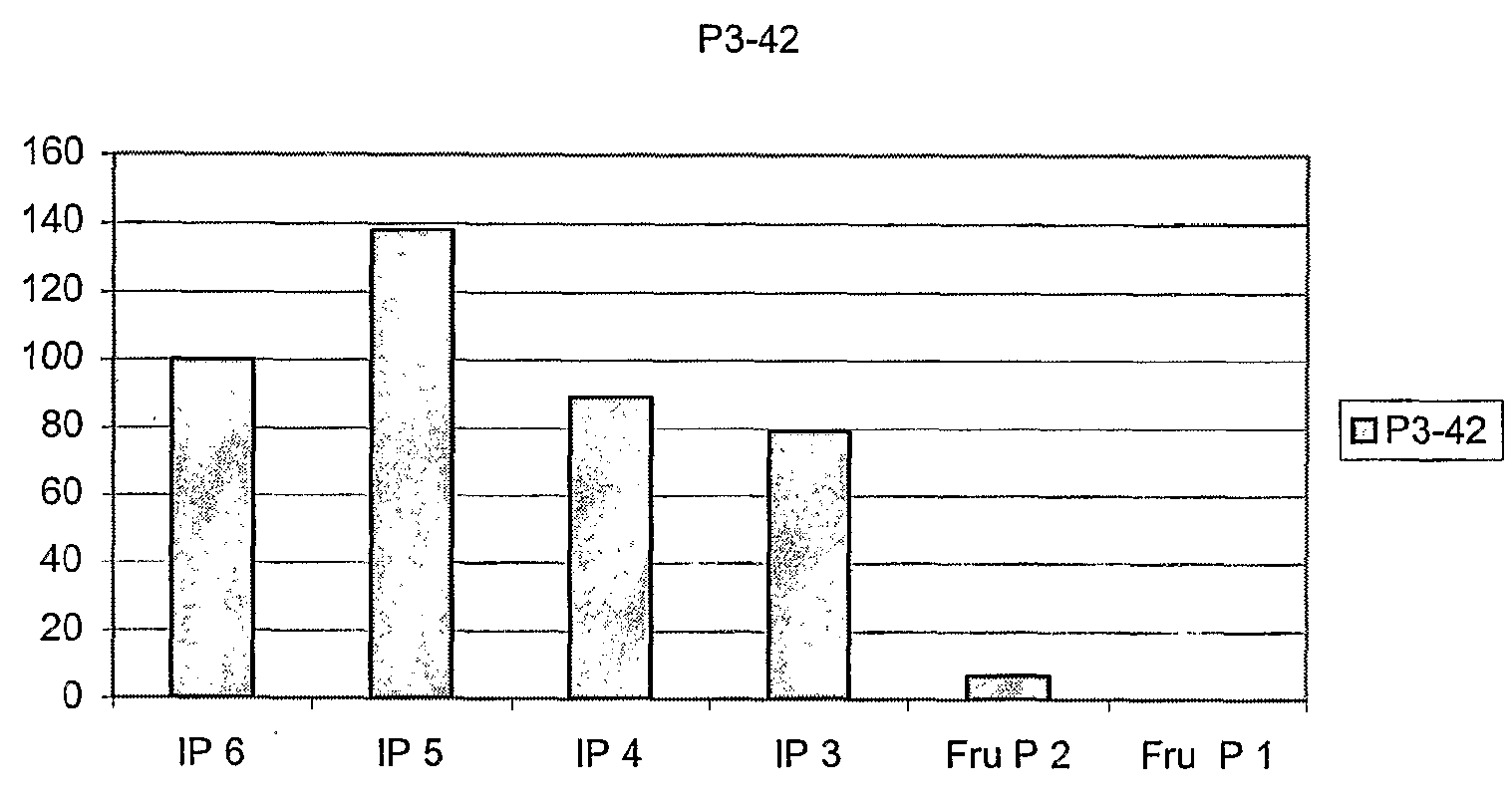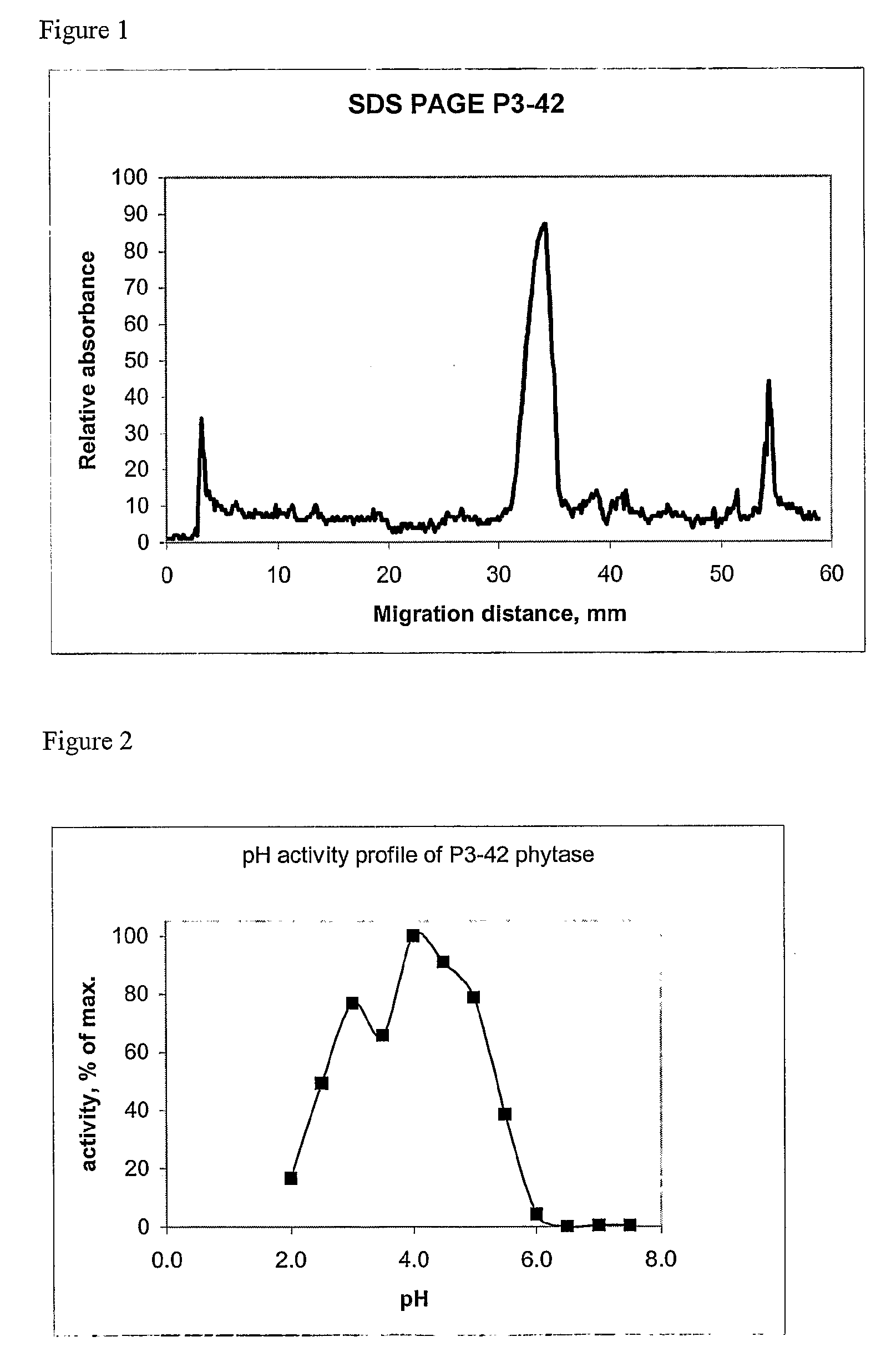Enzymes
a technology of enzymes and phytases, applied in the field of enzymes, can solve the problems of increasing pollution problems, phosphorous pollution in livestock intensive areas, and none of these phytases display the properties required for effective us
- Summary
- Abstract
- Description
- Claims
- Application Information
AI Technical Summary
Benefits of technology
Problems solved by technology
Method used
Image
Examples
example 1
[0334]Phytase assays were carried out in microtitre plates. The reaction mixture (100 μl) contained: 2 mM phytate and 0.8 mM CaCl2 in 200 mM sodium acetate buffer, pH 3.5. The reaction was allowed to proceed for 1 h at 37° C. after which time the released phosphate was measured by a modification of a known procedure (Heinonen J. K., Lahti R. J. Anal Biochem. 113 (2), 313-317 (1981)). Briefly, 200 μl of a freshly prepared AMM solution (7.5 NH2SO4, 15 mM ammonium molybdate and acetone −1:1:2) was added to the 100 μl reaction mixture in each microtitre plate well. The absorbance at 390 nm was measured not earlier than 10 min and not later than 30 min after addition of the AMM reagent. The amount of phosphate was determined by building a calibration curve with phosphate solutions of known concentrations. For assaying phytase activity at different pH values the following (all 200 mM) buffers were used: glycine / HCl between pH 2.0 and 3.0, sodium acetate / acetic acid b...
example 2
Phytase-Producing Strain P3-42
[0335]Bacterial strain P3-42 was originally isolated from a mass of decaying birch leaves collected in a wet forest in southern Finland. The strain can be aerobically cultivated at 30° C. on many simple culture media e.g. LB (1% peptome, 0.5% yeast extract, 1% NaCl, pH 7.4) or low phosphate medium PP1 (1% peptone, 1%, beef extract, 0.5%, yeast extract, CaCl2-0.2M. The medium is adjusted to pH 11 with NaOH and boiled for 10 min. The precipitate is removed by filtration, pH re-adjusted to 5.5 and the medium sterilised by autoclaving for 15 min at 121° C.).
[0336]After growth in liquid PP1 medium the strain was found to exhibit phytase activity both at pH 3.5 and 5.5 (assayed as described in Example 1). The ratio of activities at 3.5 and 5.5 was about 1.5. The activity was also measured separately in the cells and culture supernatant of P3-42. According to these measurements about 90% of all phytase activity was found in supernatant. The strain was deposite...
example 3
Isolation of Chromosomal DNA from the Strain P3-42
[0337]Chromosomal DNA was prepared essentially by the standard procedure (Ausubel et al., Current Protocols in Molecular Biology, John Wiley & Sons, New York, 1996). A 250 ml culture grown overnight at 30° C. in LB medium was centrifuged at 10,000 rpm for 30 min, washed in 20 ml of 50 mM tris-HCl, 5 mM EDTA pH 8 and re-suspended in 10 ml of cold TES (50 mM tris-HCl, 5 mM EDTA, 15% glucose pH 8). Lysozyme was added to 10 mg / ml, and the cell suspension was incubated at 37° C. for 30-60 min until lysis occurred, ascertained for by dilution of 100 μl of the reaction mixture into 1 ml of 1% SDS and checking for a “slimy” consistency. At this time, SDS and Proteinase K (Sigma) were added to a final concentration of 1% and 0.5 mg / ml respectively. The reaction mixture was incubated for 30 min at 56° C. followed by addition of 2 ml of 5 M NaCl and 1.4 ml 10% cetyltrimethylammonium bromide (Sigma). The incubation was continued for 15 min 65° C...
PUM
| Property | Measurement | Unit |
|---|---|---|
| Fraction | aaaaa | aaaaa |
| Fraction | aaaaa | aaaaa |
| Fraction | aaaaa | aaaaa |
Abstract
Description
Claims
Application Information
 Login to View More
Login to View More - R&D
- Intellectual Property
- Life Sciences
- Materials
- Tech Scout
- Unparalleled Data Quality
- Higher Quality Content
- 60% Fewer Hallucinations
Browse by: Latest US Patents, China's latest patents, Technical Efficacy Thesaurus, Application Domain, Technology Topic, Popular Technical Reports.
© 2025 PatSnap. All rights reserved.Legal|Privacy policy|Modern Slavery Act Transparency Statement|Sitemap|About US| Contact US: help@patsnap.com



